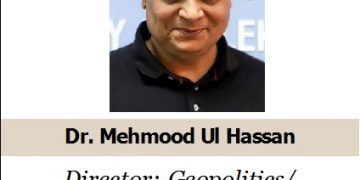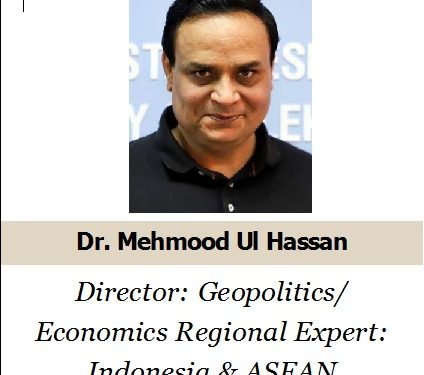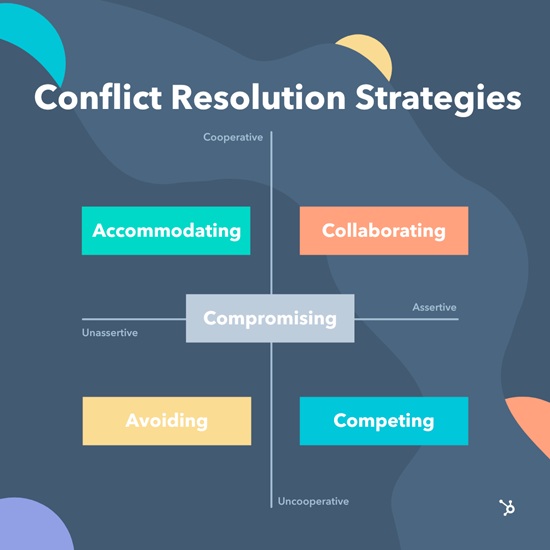The study of human history and civilization reveals that conflicting socio-economic interests, geopolitical marginalization/contradictions and geostrategic compulsions always lead towards serious conflicts which ultimately diminished state’s strength, stability and sustainability and society used to become hostage of ungoverned entities. Thus role of conflict resolution emerged as pivotal to move forward achieving desired goals of socio-economic prosperity, geopolitical stability and geostrategic sustainability.
In this connection, Indonesia has its own indigenous Model of Conflict Resolution (MCR) which it has had been applying to settle matters of territorial sovereignty, national pride, human dignity, provision of basic human rights, political isolation, economic alienation, social discrimination, cultural ambiguities, religious intolerance, administrative injustice and last but not least, traditional impasses.
Even Indonesian ancient traditions always support conflict resolution. Successive leaders and governments have been applying their own certain policies, programs and incentives to resolve various conflicts at national, region, city and last but not least a local levels due to which despite many irritants Indonesia never stuck to any dead-lock situation while dealing even with militants groups in its country.
Surprisingly, its MCR has also been instrumental to make bridges of trust, reciprocal peace, stability, concessions, befitting negotiations, meaningful dialogues and last but not least track-II diplomacy in Cambodia, Philippines and Thailand in the past which vividly reflected superior skills of communication diplomacy, politics, socio-economics and of course human psychology of its MCR.
Moreover, Indonesia’s Constitutional Court has played a significant role in its transformation from a violence-prone polity into Southeast Asia’s most stable democracy and largest economy. The Court has advanced institutional conflict resolution mechanisms and expanded democratic rights. Fortunately, the Court has been able to defend its autonomy and become an agent of democratization.
The Court succeeded because of its emphasis on high levels of power diffusion. Most importantly, it upholds that the judges’ “judicial activism remained a major tool of conflict resolution in the country.
Interestingly, Indonesian government has been institutionalizing the conflict resolution model through “problem-based learning” in junior high school which proved instrumental to restore Indonesian national identity in the time of crises. It is used to understand deeply and comprehensively about conflict resolution, problem-based learning (PBL) and the identity of the Indonesian nation. The use of PBL model provides the opportunity for students to develop their thoughts in order to resolve the conflict in the form of learning in the classroom.
In this way, students are able to feel like a real case in the field. PBL model expects to prevent conflicts. PBL proves effective to resolve conflicts that arise by instilling tolerance and mutual respect that is built up in the communication. It can also restore the Indonesian national identity through learning.
If we critically study the socio-economic and geopolitical history of Indonesia since 1998, one thing is evident that it has been rigorously undergoing a momentous political and economic transition. The fall of the New Order, the economic crisis, and radical decentralization have changed the political, economic and social context. Resultantly, power structure is transformed and transmitted, inter-state relations are in flux, various identities are being renegotiated, and institutions are keep on changing.
Fortunately, the process of total transformation also changed the concept of incentives which ultimately reshaped and redefined the role of formal and informal institutions at various levels and ultimately, individuals and groups relate to each other and the state.
In some areas such as Aceh, Kalimantan, Papua, the Malukus, and Central Sulawesi, there have been outbreaks of large-scale communal or secessionist conflict.
It is pertinent to mention that the diversity of the Indonesian nation and its territory which is in the form of islands must be accepted as an objective reality that might have potentials for conflict or sources of conflict such as separatist conflicts, struggle for natural resources, issue of race/ethnic, economic inequality, crime, unemployment, civil war, armed rebellion, politics, and so on.
Moreover, there are also potential conflicts that can lead to national integration, namely the potential for conflict between tribes, religion, race, class, regional centers, civil-military, government agencies/states, non-Java-Java, public authorities-society, and others.
Furthermore, there are also potential conflicts which are characterized by the implementation of regional autonomy, such as conflicts between local governments (adjacent to each other), conflicts between local people against the government forces, the conflict between local government and central government, and so on. Indonesia has been using its MCR to solve the various issues through dialogue, diplomacy and development which has been effective.
Indonesia is a multi-culture country. As a multi-culture country, Indonesia has many ethnics, traditions, culture and local wisdom which are giving social and cultural capital for Indonesian nations. Indonesia is a huge living laboratory for some studies like Sociology, Anthropology, Politics, conflict and culture.
Ethnic conflict in Sambas (Kalimantan), Ambon (Mollucas), Aceh (Sumatera) and Papua has now become indicator for conflict potential in heterogeneous ethnic of Indonesia. However, this heterogeneous becomes a problem where conflict of interest among various ethnic are growing, even state’s interest also included.
In this regard, Indonesian government recognizes this conflict potential in the term of SARA or suku, agama, ras and antar golongan (ethnic, religion, race and group). Unequal development, access toward natural and economic resources and law enforcement also contribute on ethnic conflict which shifted to structural problem. Some studies show that ethnic conflict in Indonesia creates violence where the differences among them are supporting with ethnic domination
The ethnic-mix relations are needed to avoid conflict and create equal relations among ethnics and keep nations unity. It is the effort to eliminate exclusive nature among group and ethnic or in the larger context it is a uniting and integrating process.
In addition to this social and culturally, Indonesia is a concept of multiethnic. Every ethnic develops autonomous communalism. They have their own specific character and attitude which are growing naturally in the specific form. They are inter-acting each other, with strong mobilization because of economic need in trade among islands. They create hetero cultural society system.
In this context, “Bhineka Tunggal Ika” is Indonesian unity symbol, means unity in diversity. It describes the unity of various ethnic to be Indonesian nation.
To conclude I really appreciate diversified but integrated models of Conflict Resolution of the Republic of Indonesia. In which its national policy of Bhineka Tunggal Ika” Indonesian unity in diversity played an instrumental role means unity in diversity.
It has rich experience of conflict resolution at national, regional, city and of course local levels. Its immense ethnic diversity has been the source of multiculturalism but also stems conflict pertaining to many minority and weaker communities living in Indonesia. That is why it has been using a Holistic Participative Based Model on Ethnic Mix Relations (HPBMEMR) to make bridges of social trust, inter-personal respect, economical peaceful co-existence and politically jelled coordination in specially, in Tionghoa and different parts of the country. This model created balanced socio-economic conditions for both the ethnic communities which ultimately diminished social alienation, economic depression and political isolation in this area.
Indonesia’s Constitutional Court has also played a pivotal role in further enhancing the potential and capacity building orientation of the Republic of Indonesia’s conflict resolution management. Its judicial activism has been rated a balancing act among the different conflict parties, groups, stakeholders and communities alike.
Indonesian model of supporting & sharing of peace-building process has been instrumental to facilitate process of negotiations in different regional countries not just confined to Cambodia, Philippines and Thailand.
Furthermore, it basic national policy of Problem-Based Learning (PBL) has been a game changer which has actually trained its youth to become a true conflict resolution practitioners. The national policy of PBL has immunized its people from self-inserted and self-defined parameters of social superiority, religious comparability, economic compatibility and last but not least political cultivation and thus shun seeds of prejudice, communal rivalry, social bigotry, economic marginalization and of course gender discrimination.
Moreover, Indonesia has been blessed with numerous local wisdoms, cultural convergences, traditional and customs which have been used to reduce chances of conflicts in the country.
Indonesia is still preserved many local wisdom tool of conflict resolution mainly, dalihannatolu (Tapanuli), rumahbetang (Kalimantan Tengah), menyamabraya (Bali), saling Jot dansalingpelarangan (NTB), siroyoingsun, ingsunyosiro (JawaTimur), alon-alonasalkelakon(Jawa Tengah/DI Yogyakarta), danbasusunsirih (Melayu/Sumatra).
Indonesia has been applying Model of National Educational Character of Conflict Resolution since inception thus stay away from plough seeds of communalism, radicalization, fanaticism and promote spirits of secularism, balanced life, rational thinking, sense of law and order etc.
The government of Indonesia also applied Model of Integrative Framework of Collaborative Governance (MIFCG) to minimize the incidents of separatism. It proved its effectiveness in case of Papuan and Aceh region etc. Where the Special Autonomy Law (SAL) shackled clutches of militant groups and ultimately sanity prevailed and guns downed silence. So through socio-economic reconstruction, meaningful incentives, provision and protection of basic human rights, geopolitical re-approachment and superior geostrategic bargaining chip the Indonesian government succeeded to win hearts and souls of the dissident voices, unsatisfied and scattered political entities and achieved peaceful transitions.
Indonesian institutionalized model of conflict resolution has been very active and assertive to resolve the issues pertaining to land acquisitions and palm oil production.
Interestingly, Indonesia has been a successful mediator, facilitator, and observer. During the Cold War era, Indonesia was praised for its active role in the Cambodian peace process, organizing the Jakarta Informal Meeting I and Jakarta Informal Meeting II. In 1990s Indonesia was actively involved in brokering peace in the Southern Philippines. Indonesia has been particularly engaged in the peace process between the Government of the Philippines (GPH) and the MNLF) at the request of the Organization of Islamic Conference (OIC) forum.
Fortunately, Indonesian non-governmental organizations (NGOs) have also played crucial facilitation roles. Muhammadiyah, an international nongovernmental organization (INGO) based in Indonesia, has participated in the International Contact Group, a hybrid mediation support initiative asked to provide support to the parties.
It also attempted to act as a mediator in Southern Thailand between the Thai government and the Muslim groups residing in the southern part of the country. The Indonesian government, led by Vice President Jusuf Kalla managed to host a peace talk in Bogor in 2008 attended by Thai officials and representatives of insurgent groups.
Indonesian rich experience of conflict resolution reveals that conflict prevention is a short-term as well as long-term strategy which must be integrated in terms of structural and operational capacities. Constant removing of horizontal economic barriers, vertical political bottlenecks, social superiority myths, religious taboos of holiness, psychological stigmas of gender and community discriminations, corruption free administration, good governance, continued national policies of cohesion, peaceful co-existence and constitutional coverage and pledges of the provision and protection of human rights may be the way forward for Indonesia. Regional power politics and role of global movers & shakers may also be scrutinized for greater socio-economic prosperity and territorial integrity of the country.






